
Hibbertia avonensis is a species of flowering plant in the family Dilleniaceae and is endemic to the south-west of Western Australia. It is a shrub with narrow oblong leaves and bright yellow flowers arranged singly in leaf axils with about ten stamens fused at their bases on one side of the two carpels.

Prostanthera baxteri is a species of flowering plant in the family Lamiaceae and is endemic to the south-east of Western Australia. It is an erect shrub with narrow egg-shaped to linear leaves and white flowers with a tinge of blue to pale mauve.
Hibbertia papillata is a species of flowering plant in the family Dilleniaceae and is endemic to the Fitzgerald River National Park in Western Australia. It is an erect shrub with crowded, linear, hairy leaves and yellow flowers usually with ten stamens, all on one side of, and curving over two hairy carpels.
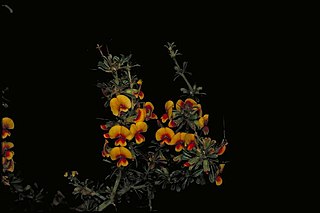
Mirbelia granitica is a species of flowering plant in the family Fabaceae and is endemic to inland areas of Western Australia. It is an erect or spreading shrub with spiny branches, scattered linear to narrowly egg-shaped leaves and yellow and red flowers.
Mirbelia rhagodioides is a species of flowering plant in the family Fabaceae and is endemic to inland areas of Western Australia. It is an erect, prickly shrub with clustered linear or narrowly elliptic leaves and yellow and red flowers.
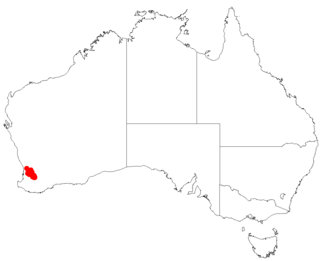
Leucopogon darlingensis is a species of flowering plant in the heath family Ericaceae and is endemic to the south-west of Western Australia. It is an erect shrub with hairy young branchlets, spirally arranged, linear, oblong, narrowly elliptic or narrowly egg-shaped leaves and white, bell-shaped flowers arranged in upper leaf axils and at the ends of branches.
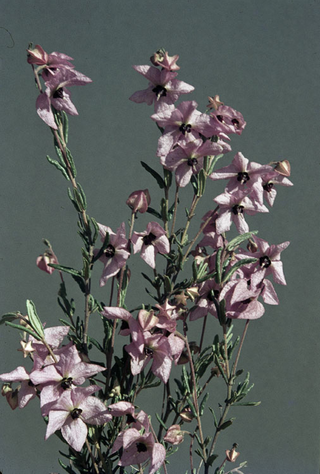
Guichenotia sarotes is a species of flowering plant in the family Malvaceae and is endemic to the southwest of Western Australia. It is a spindly, low-growing shrub with densely hairy new growth, hairy, greyish, linear leaves and pink to purple flowers arranged in loose groups of two to six.
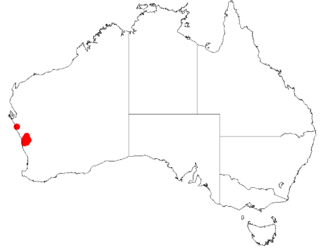
Pityrodia viscida is a flowering plant in the mint family Lamiaceae and is endemic to the south-west of Western Australia. It is an erect shrub with sticky hairy stems, egg-shaped to narrowly elliptic leaves and white bell-like flowers.
Androcalva cuneata is a species of flowering plant in the family Malvaceae and is endemic to the south-west of Western Australia. It is a low, spreading, densely hairy shrub that sometimes forms suckers and has wedge-shaped leaves and clusters of 5 to 15 pink flowers.

Androcalva fragifolia is a species of flowering plant in the family Malvaceae and is endemic to the south-west of Western Australia. It is a straggling, prostrate shrub with glossy, broadly egg-shaped leaves, and creamy white flowers.

Guichenotia angustifolia is a species of flowering plant in the family Malvaceae and is endemic to the south-west of Western Australia. It is an erect, prostrate or climbing shrub with hairy young growth, hairy, oblong to linear leaves and pink to mauve flowers.
Guichenotia anota is a flowering plant in the family Malvaceae and is endemic to a restricted part of the southwest of Western Australia. It is a low, erect, compact shrub with hairy new growth, oblong to narrowly egg-shaped leaves, and pinkish-purple flowers.
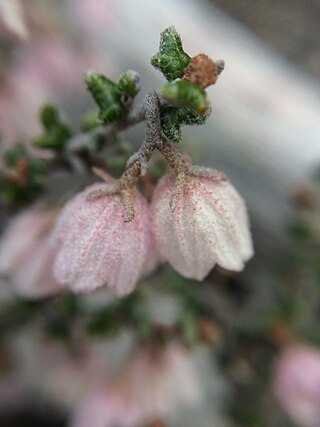
Guichenotia apetala is a flowering plant in the family Malvaceae and is endemic to a small area in the southwest of Western Australia. It is a small, erect, compact shrub with many branches, densely hairy new growth, triangular to heart-shaped leaves, and salmon pink flowers.
Guichenotia asteriskos is a flowering plant in the family Malvaceae and is endemic to the southwest of Western Australia. It is a dwarf, spreading shrub with hairy new growth, linear to narrowly egg-shaped leaves, and white flowers.
Guichenotia astropletha is a flowering plant in the family Malvaceae and is endemic to the southwest of Western Australia. It is a dwarf, spreading shrub with hairy new growth, linear to narrowly egg-shaped leaves, and pink flowers.
Guichenotia basiviridis is a flowering plant in the family Malvaceae and is endemic to the far west of Western Australia. It is an erect, spreading shrub with hairy new growth, linear leaves with the edges rolled under, and pink flowers arranged in groups of three to seven.
Guichenotia impudica is a species of flowering plant in the family Malvaceae and is endemic to the south-west of Western Australia. It is a spreading, dwarf shrub with hairy new growth, more or less linear leaves with the edges turned down, and pink flowers arranged in groups of six or seven.

Guichenotia micrantha, commonly known as small flowered guichenotia, is a species of flowering plant in the family Malvaceae and is endemic to the south-west of Western Australia. It is a low, compact shrub with linear to narrowly egg-shaped leaves and pink flowers in groups of three to six.
Guichenotia quasicalva is a species of flowering plant in the family Malvaceae and is endemic to the south-west of Western Australia. It is a low, spindly shrub with narrowly egg-shaped to linear leaves and pink flowers in groups of two to four.
Guichenotia tuberculata is a species of flowering plant in the family Malvaceae and is endemic to the south-west of Western Australia. It is a low, spreading shrub with linear to narrowly egg-shaped leaves and dark pink flowers arranged in groups of two to five.










